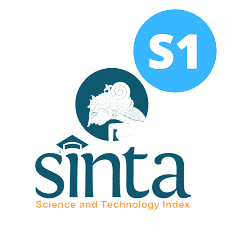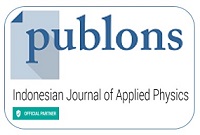Effect of Coating Superparamagnetic Iron Oxide Nanoparticles with Oleic Acid and PEG on Their Properties For Magnetic Targeting Applications: A Review
Abstract
Keywords
Full Text:
PDFReferences
Khan, I., Saeed, K. 2019. Nanoparticles: Properties, applications and toxicities. Arabian J. Chem., 12(7), 908-931.
Vangijzegem, T., Lecomte, V., Ternda, I., et al. 2023. Superparamagnetic Iron Oxide Nanoparticles (SPION): From Fundamentals to State-of-the-Art Innovative Applications for Cancer Therapy. Pharmaceutics, 15, 236.
Dobson, J. 2006. Magnetic nanoparticles for drug delivery. Drug Dev. Res., 67(1), 55-60.
Choumoucka, J., Drbohlavova, J., Huska, D., Adam, V., Kizek, R., Hubalek, J. 2010. Magnetic nanoparticles and targeted drug delivering. Pharmacol. Res., 62(2), 144-149.
Wallyn, J., Anton, N., Vandamme, T. F. 2019. Synthesis, principles, and properties of magnetite nanoparticles for in vivo imaging applications – A review. Pharmaceutics, 11(11), 601.
Wahajuddin, Arora, S. 2012. Superparamagnetic iron oxide nanoparticles: Magnetic nanoplatforms as drug carrier. Int. J. Nanomed., 7, 34450-3471
Mohammad, F., Al-Lohedan, H. A., Joshi, P. B., et al. 2022. Engineered superparamagnetic iron oxide nanoparticles for externally controlled hyperthermia, drug delivery, and therapeutic toxicity. Precis. Nanomed., 5(3), 930-949.
Umut, E. 2013. Surface Modification of Nanoparticles Used in Biomedical Applications. Modern Surface Engineering Treatments. Online: https://www.intechopen.com/chapters/44855.
Doan, L., Nguyen, L. T., Nguyen, N. T. N. 2023. Modifying superparamagnetic iron oxides nanoparticles for doxorubicin delivery carriers: a review. J. Nanopart. Res., 25(73).
Ganapathe, L. S., Mohamed, M. A., Yunus, R. M., Berhanuddin, D. D. 2020. Magnetite (Fe3O4) nanoparticles in biomedical application: From synthesis to surface functionalisation. Magnetochemistry, 6(4), 68.
Ioncica, M. C., Bandyopadhyay, S., Bali, N., Socoliuc, V., Bernad, S. I. 2023. Investigation of Cubic and Spherical IONPs’ Rheological Characteristics and Aggregation Patterns from the Perspective of Magnetic Targeting. Magnetochemistry, 9(4).
Kovrigina, E., Polaetaeva, Y., Zheng, Y., Chubarov, A., Dmitrienko, E. 2023. Nylon-6-Coated Doxorubicin-Loaded Magnetic Nanoparticles and Nanocapsules for Cancer Treatment. Magnetochemistry, 9(4).
Kovrigina, E., Chubarov, A., Dmitrienko, E. 2022. High Drug Capacity Doxorubicin-Loaded Iron Oxide Nanocomposites for Cancer Therapy. Magnetochemistry, 8(5), (2022).
Namikuchi, E. A., Gaspar, R. D. L., da Silva, D. S., Raimundo, I. M., Mazali, I. O. 2021. PEG size effect and its interaction with Fe3O4 nanoparticles synthesized by solvothermal method: Morphology and effect of pH on the stability. Nano Express, 2(2).
Heydaryan, K., Kashi, M. A., Montazer, A. H. 2022. Tuning specific loss power of CoFe2O4 nanoparticles by changing surfactant concentration in a combined co-precipitation and thermal decomposition method. Ceram. Int, 48(12), 16967 – 16976.
Andhare, D. D., Patade, S. R., Khedkar, M. V., Nawpute, A. A., Jadhav, K. M. 2022, Intensive analysis of uncoated and surface modified Co-Zn nanoferrite as a heat generator in magnetic fluid hyperthermia applications. Appl. Phys. A:Mater. Sci. Process, 128(6).
Dabbagh, A., Hedayatnasab, Z., Karimian, H., et al. 2019. Polyethylene glycol-coated porous nanoparticles for targeted delivery of chemotherapeutics under magnetic hyperthermia conidition. Int. J. Hyperthermia, 36(1), 104-114.
Hemben, A., Chianella, I., Leighton, G. J. T. 2021. Surface engineered iron oxide nanoparticles generated by inert gas condensation for biomedical applications. Bioengineering, 8(3).
da Silva, P., de Moraes, C. 2016. Iron Oxide Nanoparticles Coated with Polymer Derived from Epoxidized Oleic Acid and Cis-1,2-Cyclohexanedicarboxylic Anhydride: Synthesis and Characterization. J. Mater. Sci. Eng., 5(3).
Darwish, M. S. A., Peuker, U., Kunz, U., Turek, T. 2011. Bi-layered polymer-magnetite core/shell particles: Synthesis and characterization. J. Mater. Sci., 46(7), 2123-2134.
Gyergyek, S., Makovec, D., Drofenik, M. 2011. Colloidal stability of oleic- and ricinoleic-acid-coated magnetic nanoparticles in organic solvents. J. Colloid Interface Sci., 354(2), 498-505.
Jadhav, N. V., Prasad, A. I., Kumar, A., Mishra, R., Dhara, S., et al. 2013. Synthesis of oleic acid functionalized Fe3O4 magnetic nanoparticles and studying their interaction with tumor cells for potential hyperthermia applications. Colloids Surf., B, 108, 158-168.
Zhang, L., He, R., Gu, H. C. 2006. Oleic acid coating on the monodisperse magnetite nanoparticles. Appl. Surf. Sci., 253(5), 2611-2617.
Nalle, F. C., Wahid, R., Wulandari, I. O., Sabarudin, A. 2019. Synthesis and characterization of magnetic Fe3O4 nanoparticles using oleic acid as stabilizing agent. Rasayan J. Chem., 12(1), 4-21.
Barnakov, Y. A., Idehenre, I. U., Basun, S. A., Tyson, T. A., Evans, D. R. 2019. Uncovering the mystery of ferroelectricity in zero dimensional nanoparticles. Nanoscale Adv., 1(2), 664-670.
Leuner, C., Dressman, J. 2000. Improving drug solutibility for oral delivery using solid dispersions. Eur. J. Pharm. Biopharm., 50(1), 47-60.
Zhang, Y., Kohler, N., Zhang, M. 2002. Surface modification of superparamagnetic magnetite nanoparticles and their intracellular uptake. Biomaterials, 23(7), 1553-1561.
Gupta, A. K., Gupta, M. 2005. Synthesis and surface engineering of iron oxide nanoparticles for biomedical applications. Biomaterials, 26(18), 3995-4021.
Yallapu, M. M., Foy, S. P., Jain, T. K., Labhasetwar, V. 2010. PEG-functionalized magnetic nanoparticles for drug delivery and magnetic resonance imaging applications. Pharm. Res., 27(11), 2283-2295.
Abdullah, F. Z., Ma’amor, A., Daud, N. A., Hamid, S. B. A. 2017. Selective synthesis of peg-monoester using cesium heteropoly acid as heterogeneous catalyst. Quim. Nova, 40(5), 506-512.
Chouly, C., Pouliquen, D., Lucet, I., Jeune, J. J., Jallet, P. 1996. Development of superparamagnetic nanoparticles for MRI: effect of particle size, charge and surface nature on biodistribution. J. Microencapsulation, 13(3), 245-255.
Maguire, C. M., Rosslein, M., Wick, P., Prina-Mello, A. 2018. Characterisation of particles in solution – a perspective on light scattering and comparative technologies. Sci. Technol. Adv. Mater., 19(1), 732-745.
Honary, S., Zahir, F. 2013. Effect of Zeta Potential on the Properties of Nano-Drug Delivery Systems – A Review (Part 1). Trop. J. Pharm. Res., 12(2).
Kolhatkar, A. G., Jamison, A. C., Litvinov, D., Wilson, R. C., Lee, T. R. 2013. Tuning the magnetic properties of nanoparticles. Int. J. Mol. Sci., 14(8), 15977-16009.
Kotitz, R., Weitschies, W., Trahms, L., Semmler, W. 1999. Investigation of Brownian and Neel Relaxation in Magnetic Fluids. J. Magn. Magn. Mater., 201, 102-104.
Refbacks
- There are currently no refbacks.
















